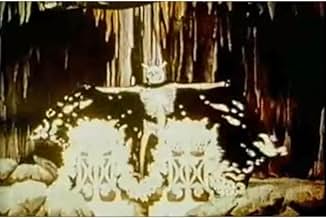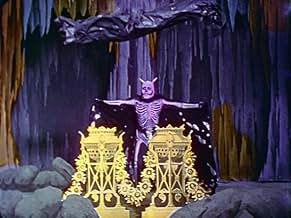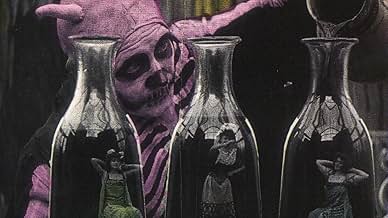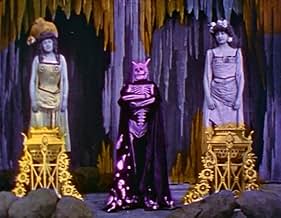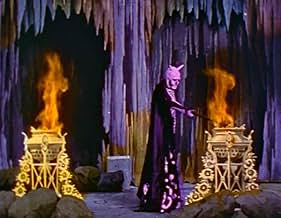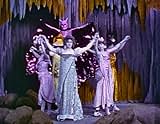AVALIAÇÃO DA IMDb
6,5/10
1,3 mil
SUA AVALIAÇÃO
Adicionar um enredo no seu idiomaA demonic magician attempts to perform his act in a strange grotto, but is confronted by a Good Spirit who opposes him.A demonic magician attempts to perform his act in a strange grotto, but is confronted by a Good Spirit who opposes him.A demonic magician attempts to perform his act in a strange grotto, but is confronted by a Good Spirit who opposes him.
Avaliações em destaque
In the late 19th and early 20th century, Georges Méliès was a very successful filmmaker. Much of it was because Méliès was originally a stage magician and he thought like one when making films. As a result, many of his films look like magic shows and the director used a lot of camera tricks to make things seemingly appear and disappear. Soon, others began copying his films....and among them, the Spaniard, Segundo de Chomón, was among the best....though his versions of the great master's films often were second-rate in quality.
"Le Spectre Rouge" is one of the best Chomón films to watch. This is because he crams every sort of camera trick into the film plus it's all in the form of a magic show. And, to get it all there, the film is about 9 minutes in length....which is amazingly long when the average movie was about one to two minutes long! As a result, you get a great homage to Méliès...one where you can see a lot of film footage showing his techniques which Chomón copied. This footage is all in the form of a weird caped skeleton-demon performing magic tricks until the tables are turned on him.
As far as how watchable all this is, it depends on you. If you love very, very early films by all means watch. Otherwise, you might find it tough going even if the film is technically brilliant.
"Le Spectre Rouge" is one of the best Chomón films to watch. This is because he crams every sort of camera trick into the film plus it's all in the form of a magic show. And, to get it all there, the film is about 9 minutes in length....which is amazingly long when the average movie was about one to two minutes long! As a result, you get a great homage to Méliès...one where you can see a lot of film footage showing his techniques which Chomón copied. This footage is all in the form of a weird caped skeleton-demon performing magic tricks until the tables are turned on him.
As far as how watchable all this is, it depends on you. If you love very, very early films by all means watch. Otherwise, you might find it tough going even if the film is technically brilliant.
Also, the story for this is somewhat confusing; if I hadn't seen the brief plot summary on Letterboxd, I wouldn't know (until near the end anyway) that this was about a Good Woman fighting the devil or a demon of hell or whoever this guy in a robe and skull-face is. It seemed if it was about a woman who might have even been this demon's boss, or maybe even some annoying underling, screwing with this Demon-Man has a penchant for bottling up women (literally, you can see this in full close-up, and that's how it seems - a full 8 years before Griffith did it in in Birth of a Nation you get a close-up, albeit in camera and with separate shots without a cut).
But at any rate, this is a fun short because the filmmaking is clever and inventive: we're seeing the process this devil takes with his female wares/prisoners, and it's through blazing red and orange colors (thanks silent film technology!) and with a magician's eye for trickery. By the end 'good' does prevail, but the joy is in the evil, if that makes sense; it's filmmakers reveling in the villainy of this Demon, or at least playing with the line between showing something as being *bad* as in a devil, or something that is... enjoyable to do, like, uh, bottling up women and making them prisoners. Or slaves. Or, I don't know what. This is simply cool, and it also empowers women to fight Satan's ways at the end of it all! How to do that, well, don't look at this for answers to that question, just watch magic tricks!
But at any rate, this is a fun short because the filmmaking is clever and inventive: we're seeing the process this devil takes with his female wares/prisoners, and it's through blazing red and orange colors (thanks silent film technology!) and with a magician's eye for trickery. By the end 'good' does prevail, but the joy is in the evil, if that makes sense; it's filmmakers reveling in the villainy of this Demon, or at least playing with the line between showing something as being *bad* as in a devil, or something that is... enjoyable to do, like, uh, bottling up women and making them prisoners. Or slaves. Or, I don't know what. This is simply cool, and it also empowers women to fight Satan's ways at the end of it all! How to do that, well, don't look at this for answers to that question, just watch magic tricks!
Here's Segundo de Chomon challenging Melies as the master of the trick film, using the sort of magician's act that Melies did. It's a combination of stage magic and movie magic -- if you look carefully, you can see the moments when the camera stops and something is substituted.
Because whenever Melies got before the cameras and did his act -- he was a stage magician and had gotten into making movies to fill up the show at his Theatre Robert-Houdin -- you could see his pleasure in performing, there was no way that de Chomon could match that. So he stuck his unnamed performing in a skeleton costume with horns and a cape. It's so over-the-top that it's magnificent.
Because whenever Melies got before the cameras and did his act -- he was a stage magician and had gotten into making movies to fill up the show at his Theatre Robert-Houdin -- you could see his pleasure in performing, there was no way that de Chomon could match that. So he stuck his unnamed performing in a skeleton costume with horns and a cape. It's so over-the-top that it's magnificent.
Director Segundo de Chomon's THE RED SPECTRE is a wonderful, subterranean magic show, put on by the skeletal entity of the title. It features various female subjects in various tricks and fantastical situations.
Mr. De Chomon once again shows his sense of humor, along with his love of the supernatural. The special effects are, as always, some of the best of the era. Of special interest are the women in the bottles, the flip-screen images, and the reverse-action wall-building sequences.
Horror fans should find this short film fascinating, since it is one of the vintage examples of what was yet to come...
Mr. De Chomon once again shows his sense of humor, along with his love of the supernatural. The special effects are, as always, some of the best of the era. Of special interest are the women in the bottles, the flip-screen images, and the reverse-action wall-building sequences.
Horror fans should find this short film fascinating, since it is one of the vintage examples of what was yet to come...
The first decade of the twentieth century saw the production of dozens of brief "trick films" which pushed the boundaries of the new medium, and France was the capital of this activity. Georges Méliès is the best known creator of these films, but The Red Spectre, which was produced at the Pathé Studio as a collaboration between Méliès' fellow pioneers Ferdinand Zecca and Segundo De Chomon, is perhaps the most bizarre and fascinating of them all. Or at least, allowing for the fact that so many of these films are lost, it certainly ranks with the best of the survivors. It is better seen than described, genuinely dreamlike in its images and transitions, and quite strange, but quite satisfying as well. The action lasts only about 8 or 9 minutes, but when it's over you feel as if you've been permitted to visit another world. When The Red Spectre was first exhibited the black & white footage was hand-colored to produce a dazzling effect, and happily, this material survives: a color print was discovered in a junk-yard in Mexico, and purchased for $25.00!
Our setting is a mysterious underground grotto, and our "host" is a demonic magician who seems to be toying with the souls or spirits of several captive women. He causes them to levitate, then burst into flames; he captures their ashes in bottles, brings them back to life in miniaturized form, etc. The magician is opposed throughout by a Good Fairy who resembles Peter Pan (portrayed by a woman, as Peter traditionally is on stage). The precise meaning of the action is difficult to determine at times, but the central conflict amounts to a struggle between the forces of Good and Evil.
One effect is especially notable: when the wicked magician produces three glass bottles, each holding a tiny woman prisoner, and brings them downstage to allow for a close-up, the scene instantly reminds latter day viewers of a similar sequence in The Bride of Frankenstein (1935). Did James Whale see this film, or is the similarity a coincidence? Notable, too, is the depiction of a device very much like television-- strongly suggested by the evil conjurer's magic screens, each of which depicts a series of moving images. Here's a real cinematic milestone: a film that predicts the coming of T.V., and, on top of that, attributes its invention to a demon!
Our setting is a mysterious underground grotto, and our "host" is a demonic magician who seems to be toying with the souls or spirits of several captive women. He causes them to levitate, then burst into flames; he captures their ashes in bottles, brings them back to life in miniaturized form, etc. The magician is opposed throughout by a Good Fairy who resembles Peter Pan (portrayed by a woman, as Peter traditionally is on stage). The precise meaning of the action is difficult to determine at times, but the central conflict amounts to a struggle between the forces of Good and Evil.
One effect is especially notable: when the wicked magician produces three glass bottles, each holding a tiny woman prisoner, and brings them downstage to allow for a close-up, the scene instantly reminds latter day viewers of a similar sequence in The Bride of Frankenstein (1935). Did James Whale see this film, or is the similarity a coincidence? Notable, too, is the depiction of a device very much like television-- strongly suggested by the evil conjurer's magic screens, each of which depicts a series of moving images. Here's a real cinematic milestone: a film that predicts the coming of T.V., and, on top of that, attributes its invention to a demon!
Você sabia?
- CuriosidadesHas a link to the Assassino do Zodíaco (2005) case. A letter allegedly sent by the Zodiac Killer, who may have been a film buff, was signed "The Red Phantom" and could have referred to this film or to the color "Masque of the Red Death" sequence in Lon Chaney's 1925 O Fantasma da Ópera (1925).
Principais escolhas
Faça login para avaliar e ver a lista de recomendações personalizadas
Detalhes
- Tempo de duração
- 9 min
- Cor
- Mixagem de som
- Proporção
- 1.33 : 1
Contribua para esta página
Sugerir uma alteração ou adicionar conteúdo ausente

